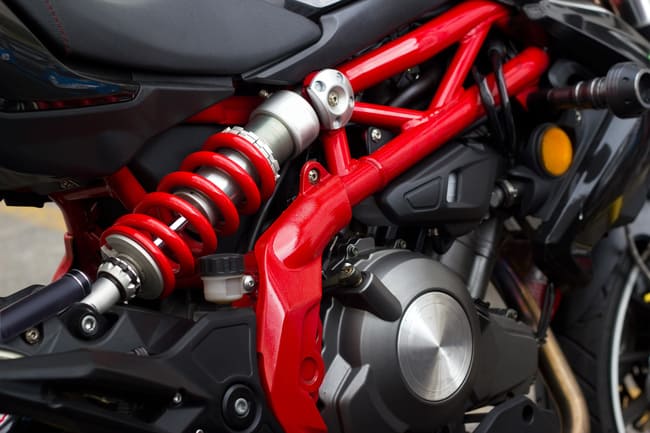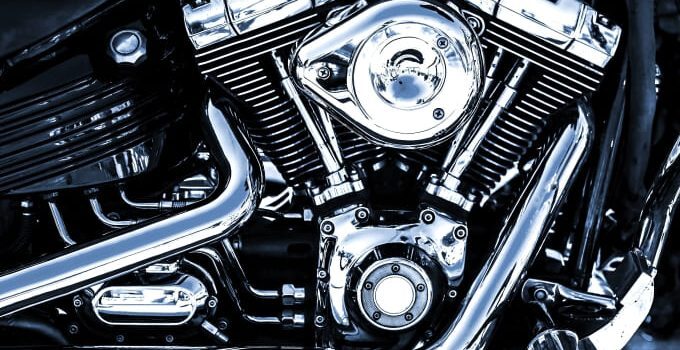
A properly set up suspension system is essential not only for ensuring your safety and protecting your bike from bumps and potholes, but also for getting the most out of your motorcycle. A badly adjusted suspension can cause the ride to feel too hard or soft and, more worryingly, lead to a loss of traction. It is therefore important to understand the system and how it affects your riding experience, as well as how to make adjustments for the optimum performance.
The basics of motorbike suspension
The suspension is the system that’s responsible for maintaining the tyres’ contact with the road, minimising the impact of dips and bumps on the surface. Motorcycles are designed with a front and rear suspension. At the front, there are normally two telescopic tubes that connect the front wheel to the bike frame, known as the forks. They essentially act like large shock absorbers, designed with internal coil springs and a hydraulic damping system. The swingarm is the main component of the rear suspension motorcycle. This H- or L-shaped component is attached to the bike chassis via a pivot bolt, which allows the arm and rear wheel connected to it to move up and down with the road surface. It works in conjunction with two shock absorbers or a single shock, and heavy duty springs.

You can find out more about the main suspension components and how they work by taking a look at the content on our blog. Check out our latest article on this topic: What is a motorcycle fork? The parts of the system can be adjusted to enhance important performance factors, such as the ride height under load, the preload tension, and damping intensity.
What’s the difference between compression damping & rebound damping?

Compression damping slows down the compression of the suspension springs when under load. Too little of this and the suspension will feel too soft and the spring will move too quickly, increasing the risk of the suspension bottoming out. Too much damping will cause excessive resistance, resulting in a stiff suspension. The spring won’t be able to compress quickly enough to fully absorb the force of an impact.
Rebound damping, on the other hand, regulates the rate at which the suspension extends and goes back to its original position after compression. If there is too much damping force, the rebound will be too slow and it could cause the wheel to lose contact with the road during compression. However, too little damping force will cause the suspension to rebound too quickly, pushing the motorcycle upwards. This may make the bike feel wobbly or too bouncy.
What is sag?
Sag is essentially the distance that the vehicle settles on the suspension under its own weight. Static sag includes how much the suspension compresses while the rider is on the bike. It is usually expressed in millimetres and inches or as a percentage of travel. Too much sag may cause the suspension to bottom out when moving over bumps or dips, whereas too little sag can result in a harsh ride.
What is preload?
Spring preload refers to how much the spring is compressed from free length while the suspension is fully extended, i.e. before the rider gets on the bike. It is a way of mechanically compressing the spring to reduce the amount of travel, before the spring is subjected to the load. It prevents the suspension from bottoming out by increasing the weight needed to compress the spring. Adjusting the preload therefore enables you to set the sag. If you increase the preload, the sag will decrease, and vice versa.
How to adjust a motorcycle’s suspension system
1. Check the condition of the components- Before proceeding with the adjustments, it is a good idea to check the seals of the system for leaks, as well as the bushings and bearings for signs of wear or deterioration. Replace the parts if necessary.
- To do this, you’ll need a tape measure, your vehicle owner’s manual and an assistant.
- Start by carefully extending the rear suspension until it is fully extended. You can do this by lifting the rear of the vehicle by hand or using a special lifting device.
- Using the tape measure, measure from the centre of the axle to a point directly above it, such as on the fender or the subframe. Note this measurement down.
- Lower the bike back down onto its suspension and bounce the suspension up and down a couple of times so that it settles into place correctly.
- Once you have done this, you’ll need to take another measurement for the ride load. To do this, the rider will need to put on their riding gear and sit in position on the motorcycle. Any luggage or pillions should also be included. Your assistant should take this measurement again.
- Divide the first measurement you took by the second measurement. The ideal standard setting for sag is at around 30% of the fully extended length.
- If the result is less than 30%, this means you may need to reduce the preload. If it is greater than 30%, the preload will need to be increased.
- Spin the retaining collar on the shock absorber/s upwards to reduce preload or downwards to increase it until the desired sag level is reached.
- To adjust the front suspension, you can use the same formula, however, this is often not necessary. Check the manual to find the preload adjusters for the specific type of fork on your motorcycle.
- Not all motorbike shocks feature adjusters for changing the damping settings, but if your bike has these adjusters, you may want to make a few changes. Check the manual to locate them. There is no magic setting for these adjustments, so you should test what works best for you.
- To set the rebound with a clicker adjuster, wind the adjustment knob clockwise all the way till it stops, counting the number of clicks as you turn. Write this number down.
- Turn the adjuster to the setting indicated in the vehicle’s manual. This will be your starting point for testing the settings.
- The compression can be set using the same method.
Top products related to this topic:








Comment